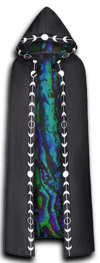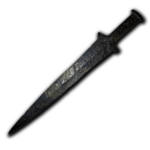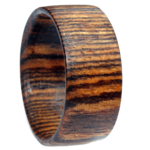Artifacts are rare, often sought-after items with special powers. The older an item's lineage is the more potential energy it carries and the more effective it may be as ab implement for blood crafts.
System: Distinguishing an actual sorcerous artifact in the wild usually requires Intelligence + Occult against a Difficulty of 2 or higher if the maker intended to conceal its nature. Some such items radiate in spectra perceptible by Auspex.
An item in ritual use for three centuries — not just any 17th-century antique — makes one die in a Ritual or other magical pool as a success: if you have a seven-die pool, flip one of them to a 9 before you roll the other six dice.
- At 600 years of magical use, the item pins two dice as successes.
- At 1,200 years of use, it pins three dice.
- At 2,400 years of use, it pins four dice, and so on.
You can’t just use the item in every ritual, though: it either has to be required in the ritual's ingredients list, or otherwise specifically, magically connected to that ritual. If there’s any doubt in the Storyteller’s mind, it’s not suitable. Of course, items that old have lots of former owners who might haunt them, have cursed them, or even come looking for them...
KNOWN ARTIFACTS
Expand
Adder Stone Ring
Adder stones are unusual glassy stones with a hole in their center. They wash up in Germany, Britain, and Egypt, where they’re called many different names: witch stones, hen gods, and aggri. In folklore, they were made from petrified serpent saliva and supposedly allowed users to turn invisible or see invisible beings. And indeed, Kindred proficient in Obfuscate seem even more so when they wear an adder stone ring. Of course, like everything, their gift comes with a cost: the wearer sometimes seems less visible, almost pale or faded out, when not using their Discipline. One Banu Haqim scholar connects the adder stone not with the saliva of serpents, but with the saliva of an unknown Antediluvian, which wipes the world’s memory of the wearer much as Kindred saliva wipes the memory of the vampiric bite.
System: Wearing the ring transforms one failure into a success when rolling an Obfuscate pool. Difficulty increases by 1 each time the wearer is successfully attacked. For every transformed failure or increased Difficulty for an attacker, the wearer loses one die from their next Social pool.
Expand
Blade of Pelops
The Blade of Pelops first surfaced in the surviving record of a series of rituals carried out on an Aegean island in the Byzantine Empire in the 9th century. It was already very much an antique by then. The text notes the unusual colors in the polished stone of the blade: a swirl of rusty red amid the patinated white of old marble. In fact, the blade is not carved from rock at all, but a piece of an enormous fossilized shoulder bone, cut into the single-edged shape of a kopis knife. Maybe it’s ancient time literally being frozen inside its blade that gives the Blade of Pelops its remarkable effect.
System: A sorcerer who cuts themselves with the Blade at the beginning of a ritual (usually to draw the Blood needed for the working) increases their Blood Potency by two for the performance of the ritual. This either adds a die to the ritual pool, or lets them re-roll the ritual’s Rouse Check, depending (Corebook, pg. 216).
Expand
Cloak of Abalone
Woven by the Tremere as a powerful weapon against Toreador, the Cloak of Abalone is dull black, brown, or grey on the outside, but opens to reveal a lining that form a scintillating shower of mesmerizing color.
System: The wearer must make a Rouse Check to activate the cloak, after which the targeted Toreador is immediately treated as if they rolled a Bestial Failure and are afflicted as if their Toreador Obsession was in effect (VtM pg. 210). Note that the cloak only works on one target at a time, and there is seldom more than one cloak per Tremere Chantry.
Expand
Humor Cups
The humor cups all look fairly innocuous simple stoneware cups— probably early Chinese pottery — each about an inch and a half in diameter. But the trained eye notices the shadow of unusual paint and burn marks underneath the cups’ dark greenish glaze. Drinking blood from them reveals their remarkable power: each cup transforms the Resonant humor of blood poured into it to another. One changes all blood poured inside it to choleric, another transforms its contents to be entirely sanguine. The blood only remains transformed as long as it’s in the cup, or if it’s been drunk. There are believed to be five of these cups in existence scattered around the globe; all that remains of a full set of twelve.
Expand
Corpse-Wax Candles
Made from rendered human fat or the adipocere that sometimes forms on buried corpses, corpse-wax candles are a grim tool to harness the energy of the grave. Making them is a long, smelly, and unpleasant process. Liquid vitae is added to the fat as the candles are poured into their molds. When they burn, the acrid smoke and wavering light surrounding the ritual are infused with pure vitae.
System: Making the candles takes at least four hours and uses Intelligence + Craft; the Difficulty equals the number of candles the vampire is making at once out of a single corpse. If they fail, they cannot simply melt the wax down and try again with the same materials; they have been spoiled by the process and cannot be reused. If successfully made and deployed in a ritual, they transform one failed die on the Ritual roll, or any associated roll into a success. Each candle only works in one ritual, after which it’s nothing but a gross (and probably criminally evidentiary) piece of décor.
The good news is, a single human body contains a lot of fat: a sorcerer can get one candle per kilogram of body mass out of most fresh First World corpses, or one candle per 5 kg of pre-burial body weight out of corpses buried over a year ago, assuming they haven’t completely skeletonized yet.
Expand
Hand of Glory
The murdering hand of a hanged man is hard to come by these days. If a sorcerer can find one — a real one — and they have a corpse-wax candle made from the body of the same man, they’ve got all the components of a Hand of Glory. Simply wrap the wrist in a cloth, fix the corpse-wax candle between its fingers, and light it. Those touched by the Hand of Glory’s glow drop into deep sleep (or torpor for Kindred), awakening only after being struck, or once the candle’s light goes out. If they were already asleep, they sleep as long as they normally would, and while the light burns, can only be awakened by being struck. The flame is weak — moving the Hand requires a Dexterity + Stealth roll to avoid it guttering out; it can be carried two meters per success before needing to stop or to re-roll. Someone holding the Hand cannot fight or move rapidly.
System: Lighting a Hand of Glory requires a Resolve + Blood Sorcery (or Occult) roll (Difficulty 4). While the Hand burns, everyone visible in its light must make a Composure + Resolve test (Difficulty 4) to resist its soporific effects, except the one who lit it. Vampires and other supernatural creatures can spend a point of Willpower to stave off the effects for a turn, if they fail the test.
Duration: The effect ends when the candle is extinguished, or when the candle burns out (after one hour).
Expand
Ironwail Blade
An ancient Bean-Sidhe was "artbound" to the blade of this shortsword in a past age. Already trapped between the Dreaming and the Shadowlands, the imprisoned Bean-Sidhe found itself twice-damned. The cold iron of the blade — anathema to fae — only caused further agony. The constant faint wail of this tortured creature, while impossible to pinpoint, seems to emit from whomever carries the weapon.
System: This shortsword has a damage value of 2. The cold iron material converts all damage to Aggravated when used against fae. While carrying the sword, take a one die penalty on rolls related to stealth.
Expand
Obsidian Mirror
The most famous obsidian mirror belonged to the Tudor philosopher and magician John Dee, who purchased it after it was taken — likely stolen — from an Aztec town in the 16th century. A single round piece of obsidian, polished to a mirror finish, they reflect not just what’s in front of them, but far-off cities, strange animals, and distant faces. Those with training in Auspex find their senses can stretch farther and broader when they gaze into the mirror’s depths, as if they’re looking through a window at the object they scry.
System: Before using an obsidian mirror, roll Intelligence + Occult against Difficulty 3 to attune your senses to the mirror. On a win, add one die to Auspex pools when using the mirror. This is especially useful for Premonition (Auspex 2) and Clairvoyance (Auspex 5), but the clever seer can figure out other ways to incorporate the mirror into Auspex power use. Obsidian mirrors cannot transmit sound.
Expand
Rowan Ring
Rowan Rings are feared tools of assassination employed by elder members of the Banu Haqim or their trusted neonates. They appear to be simple wooden rings, but can be transformed into a sharp stake in an instant. They are detectable as magical with Auspex or other occult means.
System: After making a Rouse Check, the ring mystically sharpens and elongates into a wooden stake that can be used to make a stake attack (Corebook, pg. 221). The stake detaches after use and the ring falls off its wielder’s finger. A simple thought transforms the stake back into a ring when not in use.
TOMES & GRIMOIRES
To emphasize that learning redworking is hard work, define the specific rituals or formulae a given work provides. Some very clear or magically forceful books might speed the learning process from the standard square of the Ritual’s Level in weeks: halving it, or reducing it by two-thirds. In addition to blood craft knowledge, many tomes might provide the equivalent of a free Specialty in Occult, or a bonus on a Memoriam pool investigating its revelations. Only the most powerful and versatile of texts should add even one die to Blood Sorcery or Thin- Blood Alchemy pools across the board, although adding one die to specific kinds of rituals, formulae, or wards makes a fair compromise.
Expand
Das Tiefe Geheimnis
This book is probably the most common text on Blood Hermeticism. Written in the 15th century by Johanna Kloepfer, a member of the Cologne chantry, Das Tiefe Geheimnis explains not only the basic tenets of blood sorcery and its history, but also the minutiae and methods of casting many of its most common rituals and workings. Unfortunately for students hoping to find a catch-all textbook, Kloepfer’s explanations are full of gaping omissions and strange errors, making her work only useful when read in correlation with other books. But even supplementing just one other book, it reveals a great deal. It’s commonly believed that Kloepfer’s mistakes weren’t careless, but purposefully scattered through the book to make it difficult for a layperson to follow – a common practice among mortal and Kindred philosophers of her day.
Kloepfer originally wrote her book in German, but as the centuries, passed the work was translated into most European languages, titled some variation on The Deep Secret. Almost any library with texts on Blood Sorcery has a copy of this book, translated into their native language. An experienced student of the art may have read the book several times over, and maybe even added to the extensive notes, corrections, and marginalia fellow scholars have added around the pages for five hundred years.
System: As long as the vampire has it available to consult, it grants the Blood Craft specialty to Occult. To discover a new ritual in an annotated copy of Kloepfer, spend a number of nights equal to the ritual’s Level studying the book (no hunting) and make an Intelligence + Investigation (Cryptography) test at a Difficulty equal to the ritual’s Level plus one. On a critical win, they learn that ritual in two-thirds of the normal time. A sorcerer cannot find more rituals in a given copy of Kloepfer than they have dots in Blood Sorcery.


